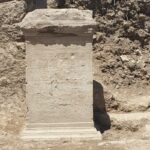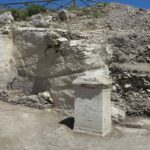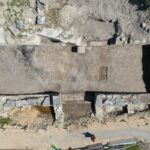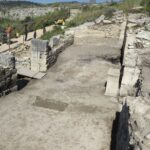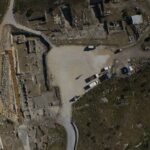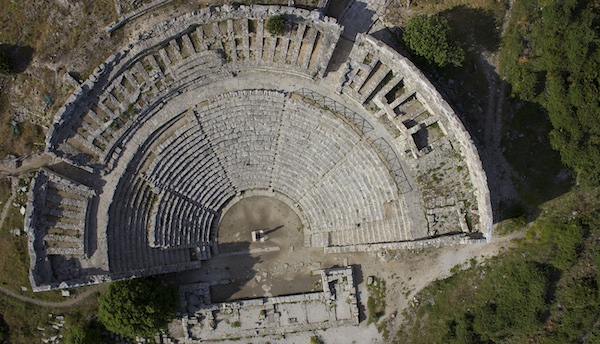
At Segesta, the Scuola Normale’s excavations in the agora – which between the late second century B.C. and the early third century A.D. played its political role, assuming from the Augustan age forms proper to a Roman forum – have brought to light an imposing architectural complex, articulated on three sloping terraces according to models from Asia Minor and Central Italy. The Hellenistic agora was punctuated on the north by a large stoa with projecting alae, one of the most monumental two-tiered stoai known to us: over 100 m long, with alae measuring 19 m, differentiated both in plan and function: the East one intended partly for offices at the level of the square, partly for warehouses in the part sloping down the hillside following patterns of Asia Minor market buildings; the West one, with the large spaces of its two aisles, for multiple functions – a place for meeting, conversation and shelter, a venue for civil, commercial and public office activities, a space for the display of ‘images’ and for the publication of normative and honorary texts –.
To the south, where investigations are ongoing, a second stoa bordered the agora, forming a body with sloping structures along the southern hillside, extending perhaps over the entire slope. A monumental elevation, therefore, of which we know for now the eastern end with the market building below the east wing of the north stoa, and a large room (c. 16 x 5 m) in the central part connected, in a way still to be clarified, with the large agora located at a higher elevation of about m 7. The exceptional discovery of a statue base still in situ, with perfectly preserved inscription and in axis with the monumental access passage, has given the key to the functional interpretation of the room, thanks to the mention of a building defined as ephebikòn, built at his own expense by Tittelos father of the dedicator Diodoros: the reference to the practices of the Segestan gymnasium, of which perhaps the room was part, is clear.
In Roman times a small square outside the agora – by then having become a forum – was built at the expense of M. Onasus and M. Sopolis, as recalled by a large inscription running throughout this small forum adiectum, near which the macellum was also located. The area of the agora was reoccupied, after sporadic frequentation in Late Antiquity, by a large settlement from the Norman-Swabian period.
The SAET 2020-2025 project for Segesta is articulated in archaeological activity at the site and in publishing. Knowing the entire development of the monuments built along the southern slope of the agora facing downstream and defining the architectural solution chosen to connect them to the large upper square are the goals of the continuing archaeological investigations. On the publishing side, after the definitive edition of the inscriptions of Segesta (Inscriptiones Segestanae. Le iscrizioni greche e latine di Segesta, edition, translation and commentary by C. Ampolo and D. Erdas, Pisa 2019), a second volume will collect and comment on the literary sources to offer, along with the first, a complete reconstruction of the political, social and economic events of the Segesta community. Other volumes in preparation concern the buildings of the upper terrace, including the bouleuterion, the forum area of Onasus and Sopolis, and the complex of buildings of the Hellenistic agora, including in particular the stoai that defined its space to the north and south.
The SAET also continues the development – with georeferencing of structures and materials – of the GIS system already implemented for the agora area, to be extended to the entire site of Segesta in the now more widespread form of Web GIS; as well as the creation 3D models from aerophotogrammetry to make the monumental complexes usable to a wider public.
Scientific coordinators: Anna Magnetto, Carmine Ampolo, Maria Cecilia Parra
Contributors: Leon Battista Borsano, Donatella Erdas (University of Milan), Chiara Michelini, Scuola Normale students, and students from partner Universities.
“Passeggiando per l’antica Segesta… in Normale. le Inscriptiones Segestanae”


